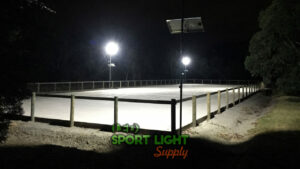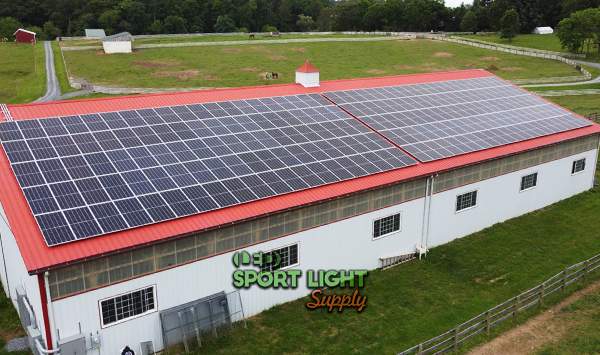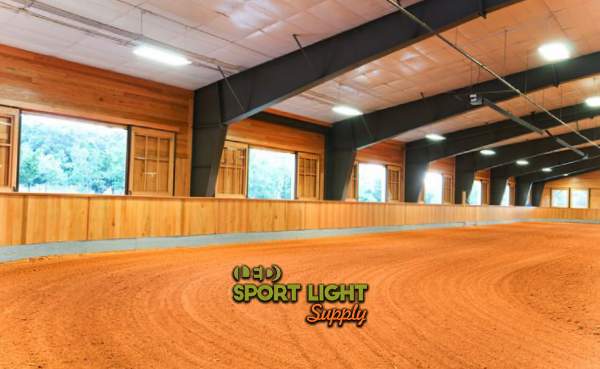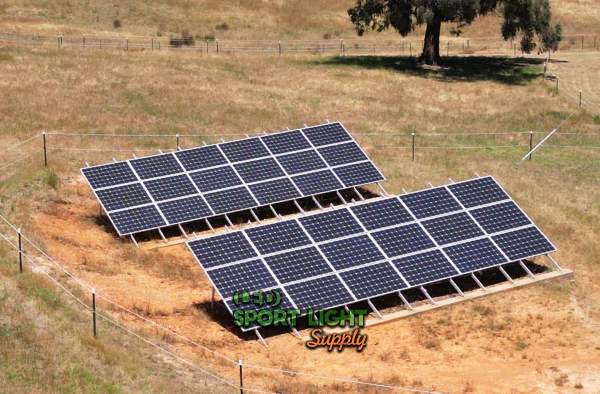
Horse arenas require reliable lighting solutions to ensure the safety of both horses and riders, especially during evening training sessions or events. With the growing need to adopt more sustainable practices, solar-powered lighting systems have become an innovative approach to illuminating these equestrian facilities. Solar technology, combined with energy-efficient LED fixtures, offers a sustainable solution that not only reduces energy costs but also minimizes environmental impact. By harnessing the power of the sun, equestrian arenas can achieve reliable and efficient lighting that operates year-round, regardless of grid connectivity or rising utility costs.
Table of Contents
Toggle Solar lighting technology utilizes photovoltaic panels to convert sunlight into electricity, which can be used to power LED lighting fixtures. The process is simple yet effective. Sunlight is captured by solar panels during daylight hours, and this energy is either used immediately or stored in batteries for later use. This system is particularly beneficial for outdoor environments such as horse arenas, where electrical infrastructure may be limited or costly to install.
Solar lighting technology utilizes photovoltaic panels to convert sunlight into electricity, which can be used to power LED lighting fixtures. The process is simple yet effective. Sunlight is captured by solar panels during daylight hours, and this energy is either used immediately or stored in batteries for later use. This system is particularly beneficial for outdoor environments such as horse arenas, where electrical infrastructure may be limited or costly to install.
Solar-powered lighting systems offer the advantage of being self-sufficient. They reduce dependence on the traditional power grid, lowering operational costs for equestrian facilities while promoting sustainability. Additionally, the integration of solar lighting allows for the utilization of an abundant, renewable energy source, which aligns with the growing shift towards environmentally friendly practices within the equestrian community.
Equestrian facilities often cover large areas, making them ideal candidates for solar technology. By switching to solar-powered LED lighting, horse arenas can significantly reduce their carbon emissions. This not only supports sustainability initiatives but also demonstrates a commitment to eco-conscious practices. The reduction in greenhouse gas emissions aligns with broader goals of reducing the environmental footprint of equestrian sports, contributing to a healthier planet.
One of the key benefits of combining solar technology with LED lighting fixtures is the energy efficiency it offers. LED lights are known for their low energy consumption, using up to 75% less electricity than traditional incandescent bulbs. This energy efficiency is particularly advantageous when paired with solar systems, as it ensures that the harvested solar energy is used effectively.
 The reduced energy consumption of LED lights translates to less strain on the solar panels and batteries. By using less power, the overall system’s lifespan is extended, reducing the need for frequent replacements or maintenance. This efficiency results in long-term cost savings, making solar LED systems an economically viable option for horse arenas.
The reduced energy consumption of LED lights translates to less strain on the solar panels and batteries. By using less power, the overall system’s lifespan is extended, reducing the need for frequent replacements or maintenance. This efficiency results in long-term cost savings, making solar LED systems an economically viable option for horse arenas.
LED fixtures are also designed to last significantly longer than conventional lighting, often exceeding 120,000 hours of operation. This extended lifespan further contributes to reduced maintenance costs, as equestrian facilities spend less on replacing burnt-out bulbs and fixtures.
Unlike traditional lighting solutions that may cast uneven light or create shadows, LED fixtures ensure even distribution. This is especially beneficial in horse arenas where consistent lighting enhances visibility, contributing to rider safety during evening events or training sessions.
Horse arenas are subject to varying weather conditions, making durability a key consideration for lighting systems. LED fixtures are engineered to withstand the rigors of outdoor environments, providing reliable performance regardless of weather conditions. The robust construction of these lights makes them resistant to impacts, vibrations, and other challenges that may arise in an equestrian setting.
LED lights are built with materials that resist damage from external forces, ensuring they can withstand the activities common in horse arenas. Whether it’s sudden movements of horses, the vibrations from machinery, or accidental impacts, the sturdy construction of LEDs ensures that they remain functional.
The sealed design of LED fixtures also prevents dust, dirt, and moisture from affecting the internal components, which is crucial in arenas where dust from riding surfaces can be pervasive. This weather-resistant quality helps extend the life of the lighting system, reducing the need for replacements.
 To capture the maximum amount of sunlight, solar panels are typically angled towards the south, as this orientation aligns with the sun’s trajectory. This strategic positioning ensures that the panels receive the highest possible level of solar radiation throughout the day, optimizing energy generation.
To capture the maximum amount of sunlight, solar panels are typically angled towards the south, as this orientation aligns with the sun’s trajectory. This strategic positioning ensures that the panels receive the highest possible level of solar radiation throughout the day, optimizing energy generation.
When planning the layout of LED fixtures in a horse arena, attention must be paid to the distribution of light. Proper placement ensures that there are no dark spots or areas with insufficient illumination. This is vital for the safety of both riders and horses, as it reduces the risk of accidents during nighttime activities.
Arena lighting should be designed to minimize glare, which can distract horses and riders. Using shields or directional fixtures helps focus the light where it’s needed while avoiding direct exposure to the eyes of horses and riders. Properly distributed lighting enhances visibility, contributing to a safer and more enjoyable riding experience.
The positioning of solar panels should also take into account seasonal variations in sunlight. Adjustments to the angle of the panels may be necessary during different times of the year to maximize energy capture. Additionally, ensuring that panels are free from obstructions, such as overhanging branches or nearby structures, will help maintain consistent performance throughout the year.
Solar lighting systems for horse arenas often incorporate batteries that store excess energy for use during the evening or on cloudy days. These batteries are a critical component of the system, ensuring that lighting remains available even when sunlight is not directly accessible. The choice of batteries can significantly impact the performance and reliability of the entire system.
Selecting high-quality batteries with sufficient storage capacity ensures that solar-powered lighting systems can operate for extended periods without interruption. Lithium-ion batteries are commonly used in these systems due to their long lifespan, high energy density, and efficient charging cycles. These batteries also feature advanced management systems that help optimize performance, preventing issues such as overcharging or deep discharge.
To prolong battery life, modern solar systems include features such as battery management systems (BMS) that monitor the charging and discharging cycles. Proper maintenance, such as regular inspections and cleaning of battery terminals, can help ensure optimal performance. Investing in reliable batteries not only enhances the resilience of the system but also reduces long-term maintenance costs.
Since horse arenas are outdoor environments, the lighting systems must be able to withstand diverse weather conditions. Solar-powered LED lighting systems are specifically designed to be weather-resistant, allowing them to operate efficiently in rain, snow, or extreme temperatures.
The durability of LED fixtures is enhanced through the use of high-quality materials that protect against corrosion, UV damage, and moisture ingress. These features ensure that the lighting systems continue to function even in harsh weather conditions, reducing the need for frequent repairs or replacements.
Withstands both high heat and freezing temperatures, solar-powered lighting is designed to operate efficiently throughout the year. The ability to maintain consistent illumination under different climatic conditions is particularly valuable for equestrian facilities, where activities often occur regardless of weather.
Adopting solar-powered lighting systems is an effective way for equestrian facilities to reduce their carbon footprint. By transitioning away from fossil fuel-based electricity, arenas can decrease their contribution to greenhouse gas emissions. This shift aligns with the broader push towards sustainable practices in various industries, including the equestrian sector.
Many equestrian facility owners are increasingly conscious of their environmental impact. Implementing solar technology demonstrates a commitment to sustainability, which can enhance the reputation of the facility among environmentally conscious riders and event organizers. The reduced reliance on non-renewable energy sources also contributes to the long-term goal of promoting green energy solutions in sports and recreational spaces.
Switching to solar-powered LED lighting offers substantial cost savings for horse arenas. While the initial investment in solar panels, batteries, and LED fixtures may be significant, the long-term savings in energy costs and maintenance are considerable. These systems require minimal ongoing maintenance, reducing both labor and replacement expenses.
By eliminating the need for traditional electricity, solar-powered lighting reduces monthly utility bills. Additionally, because LED fixtures have longer lifespans and lower maintenance requirements, arenas can further reduce operational costs. These savings free up resources that can be reinvested into other areas of facility improvement, enhancing the overall quality of services offered to riders.
The long-term financial benefits of solar-powered lighting often outweigh the initial costs. Many equestrian facility owners find that they can recover their investment within a few years through energy savings and reduced maintenance expenses. As solar technology continues to advance and become more affordable, the return on investment is expected to improve further.
Solar-powered LED lighting systems provide an efficient, sustainable, and cost-effective solution for horse arenas. By leveraging renewable energy and modern LED technology, equestrian facilities can enhance safety, reduce their environmental impact, and achieve significant cost savings. The combination of durability, energy efficiency, and minimal maintenance makes solar lighting an ideal choice for arenas looking to adopt more sustainable practices.
Drop us a line to receive a free lighting design